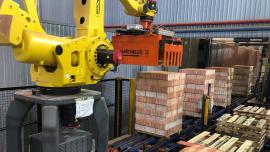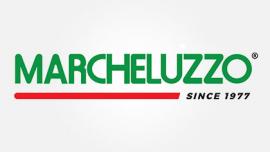High-efficiency ventilation in brick and roof tile drying
The latest technologies developed by Marcheluzzo SpA are designed specifically to offer improved performance, greater energy efficiency and lower production costs in the dryer process.
Thousands of years have gone by since humans first began using clay as a primary material for the construction of monuments and dwellings. Clay building elements have been widely used ever since the earliest civilisations, and their production techniques have seen slow but steady development over the millennia. What were initially manual systems gradually underwent simple mechanisation, eventually leading to full-scale automation of production processes. Drying technology in particular has seen enormous progress. Long gone are the days when bricks and roof tiles were dried naturally in the air and the sun, with all the variability that this entails in terms of environmental conditions. But despite all the progress that has been made, it is important to remember that this is still the most complex stage of the production process and must be monitored very closely to ensure a high-quality finished product.
The metamorphosis of clay
The clay product drying process is influenced by a number of interrelated factors, first and foremost the nature of the raw material and the drying method and duration.
The clay raw material has an internal structure made up of very fine lamellar particles distributed in a disorderly manner and held together by thin water films that give it plasticity. This water content needs to be removed without subjecting the material to stress in order to ensure its integrity. After being formed, the piece is introduced into the dryers where it is heated in optimal conditions to allow for evaporation and ensure that the material has the correct residual water content upon exit.
Creating the right drying conditions
The drying process is a very delicate phase, and its duration varies according to the percentage of water contained in the body and the dimensions of the pieces.
Over the years, drying processes have become faster and capable of drying large quantities of products in the shortest possible time, although this has often been at the expense of optimum heat treatment, resulting in product defects. These defects may occur on both the outer and the inner surfaces of the brick or tile and may affect both its technical and functional characteristics.
In addition to the shape and size of the pieces, another important factor in the drying process is the quality of the clay used, which must have specific characteristics in terms of particle size and fineness.
Various types of drying systems are available on the market, but all of them operate on the basis of the ratio between the quantity of air introduced into the drying chamber and the thermal energy it contains.
When we talk about creating the right drying conditions, this mainly refers to the cycle time (i.e. the length of time the products spend inside the dryer), the Bigot curves (i.e. the water loss expressed in grams per unit time) and the resulting shrinkage of the material. However, these aspects are often not sufficient and it is also necessary to create the right internal ventilation conditions using dedicated machines that take into account the quantity of air that needs to be moved, the pressure and the speed of the transiting airflow. The circulation of air inside the dryers is therefore a very important factor as it serves to transfer energy from one point to another and to reach the material undergoing drying with the maximum uniformity and homogeneity. The latest technologies developed by Marcheluzzo SpA are designed specifically to meet these needs and offer improved performance, greater energy efficiency and lower production costs.
Adjusting the internal ventilation: different systems for different requirements
Now as in the past, Marcheluzzo’s R&D department continues to conduct meticulous ongoing research into the drying process. The characteristics of the raw materials, the quality of the end product and above all energy factors are carefully evaluated in order to offer the customer the most suitable technology for his specific product.
In recent years, clay products such as masonry blocks and roof tiles have evolved in terms of their sizes and geometries and now cannot be dried using conventional systems.
For this reason, Marcheluzzo has sought to develop internally the skills it needs in order to offer effective solutions to an evolving market which, despite the current difficulties, is in search of increasingly modern and efficient technology.
The best known models of dryers are the semi-continuous and static chamber types. The operation of these dryers involves introducing variable quantities of hot air into the tunnels and then providing internal ventilation so that the hot air flows over the material positioned on dedicated supports.
Field studies conducted by Marcheluzzo have demonstrated that it is not only possible to optimise the quantity of air used, but above all that it can be carried more effectively to the product, thereby guaranteeing higher efficiency and subjecting the products to lower thermal stress.
The innovations introduced by Marcheluzzo to the internal ventilation system have led to significantly shorter cycle times, lower energy usage and a smaller percentage of rejects.
Three main types of ventilation systems are used:
- Cone ventilation: the air flows over the material at high speed, but with an impulsive and periodic flow; the cone passes in front of the drying car with a set speed and time.
- Perforated wall ventilation: the flow is constant and homogeneous for the entire duration of the cycle and over the entire height of the dryer car with air moving at low speed relative to the cone.
- DT type ventilation: this solution is similar to the perforated wall system, but with a significantly higher air flow rate over the material.
DT type drying plants for the treatment of roof tiles and perforated blocks with operating cycles of less than 10 hours are already in operation in several countries around the world.
Automated, sustainable and customised solutions
The high level of automation of Marcheluzzo’s technological solutions enables them to maintain constant control over all the functions that determine the correct operating parameters and, above all, to manage the energy involved and monitor its behaviour. Sophisticated software is used to manage the drying cycles and ensure continuous and efficient use of the energy recovered from the kilns. This approach fits in with the modern concept of sustainable development and environmental responsibility.
The various systems are also designed according to a tailor-made concept: each customer receives a specific solution based on the type of product, the type of clays used and the space available in the factory. Increasingly compact solutions with smaller dimensions are gradually replacing large systems, bringing major advantages in terms of maintenance.
Did you find this article useful?
Join the CWW community to receive the most important news from the global ceramic industry every two weeks
























